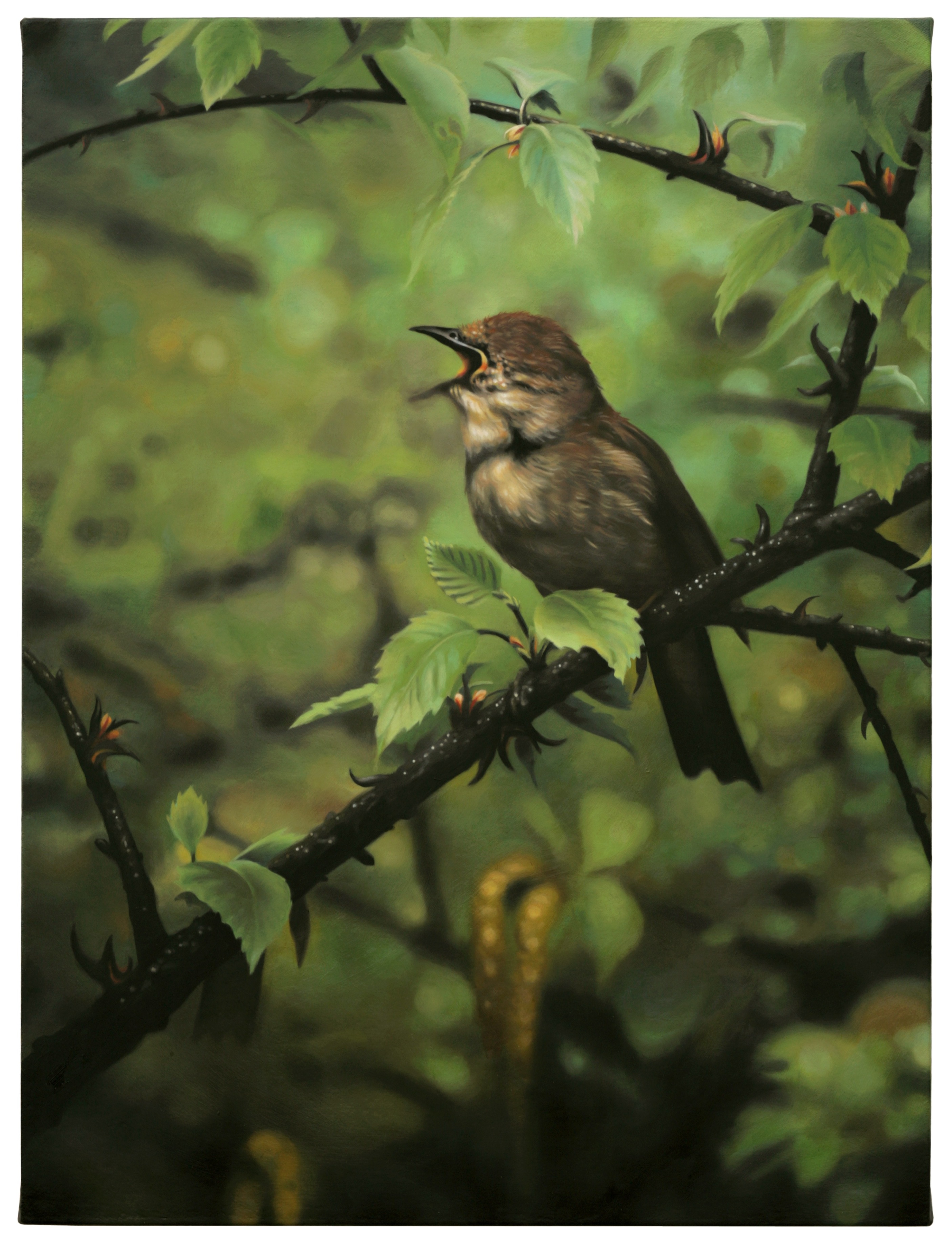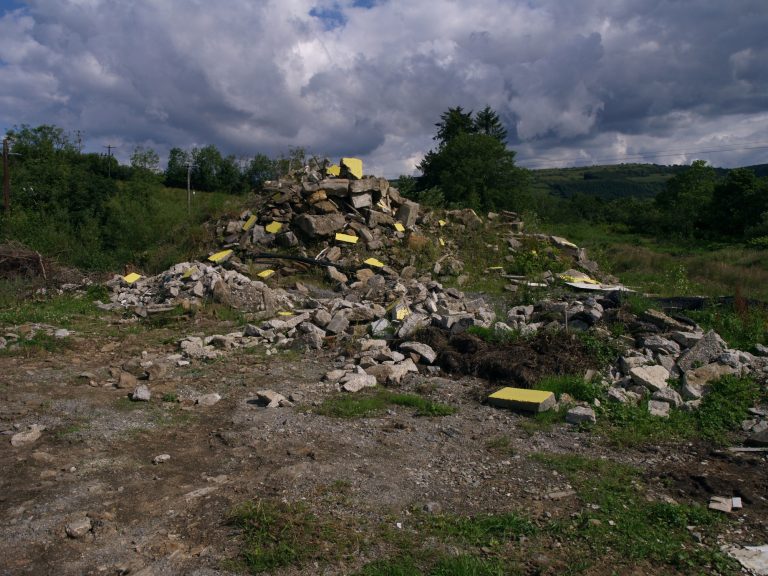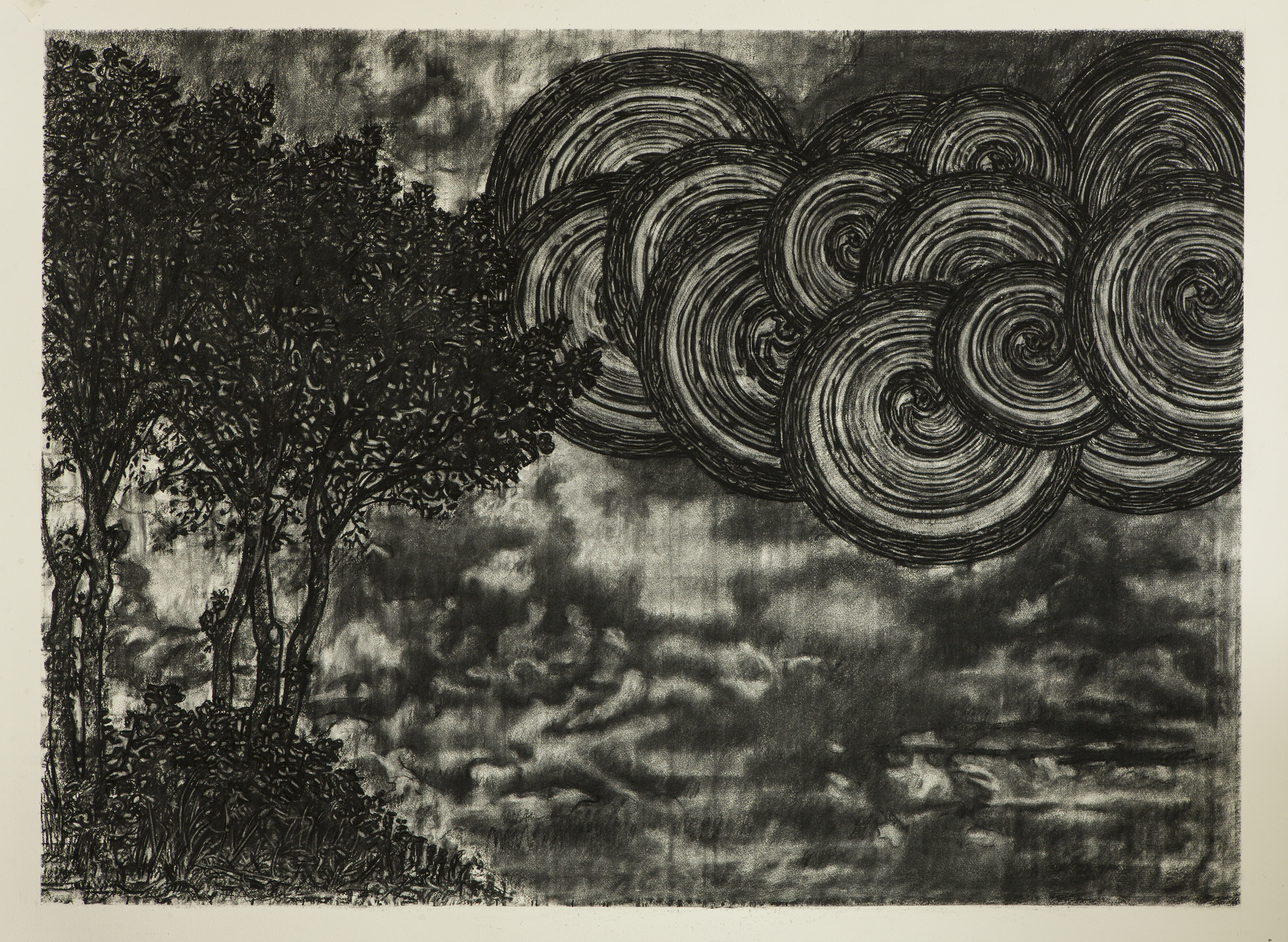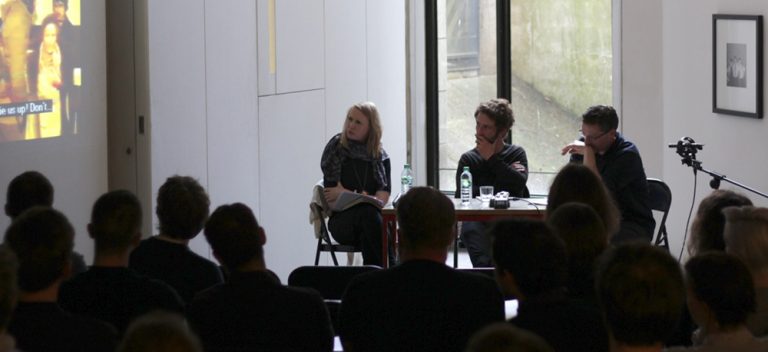A Q&A between Eoin McHugh and Pádraic E. Moore following Augury which took place at the Douglas Hyde Gallery, Dublin, from 26 July – 1 September, 2013.
P: I recall you mentioning previously that the paintings in this exhibition of new works were painted as though from the perspective of a person other than yourself. You intimated that the tone, emotional pitch, or mood of these works belonged to or suggested a character much darker and pessimistic than yourself. Perhaps you could elaborate on this a little? Does these mean that there is a particular identity or individual that that you associate with the work?
E: I see individuality as a very fluid construct, especially when concerned with the mystique and myths associated with the persona of the artist. Obviously, as much as an artist puts forward a theoretical viewpoint with any given work or exhibition, he or she also defines an image of themselves for the viewer—a similar position to an author of fiction who is forced to adopt an omniscient or first person character. As I’ve been living and working alone in a cottage in the countryside for the last three years, I wanted to deal with how living there changed the work, and how the work made there would be perceived psychobiographically. So, the exhibition evolved from a take on environmental collapse and the apocalypse, to a more particular response to these ideas. The themes became internalised and developed through an hysterical exaggeration of my own position: a lone mind, alienated and paranoid, feeding off itself in despair, and rejecting the disintegrating human world. This became more prominent in the work to the point that it became a meditation on melancholy and isolation. In actuality, I live in a very beautiful place and my life is quite mundane in its practicalities—this really keeps me quite happy. However, I can’t deny that the current environmental situation affects me deeply, along with the feeling of helplessness at being unable to effect change, and even more so the feeling of guilt that goes with making art, rather than becoming some kind of eco-activist.
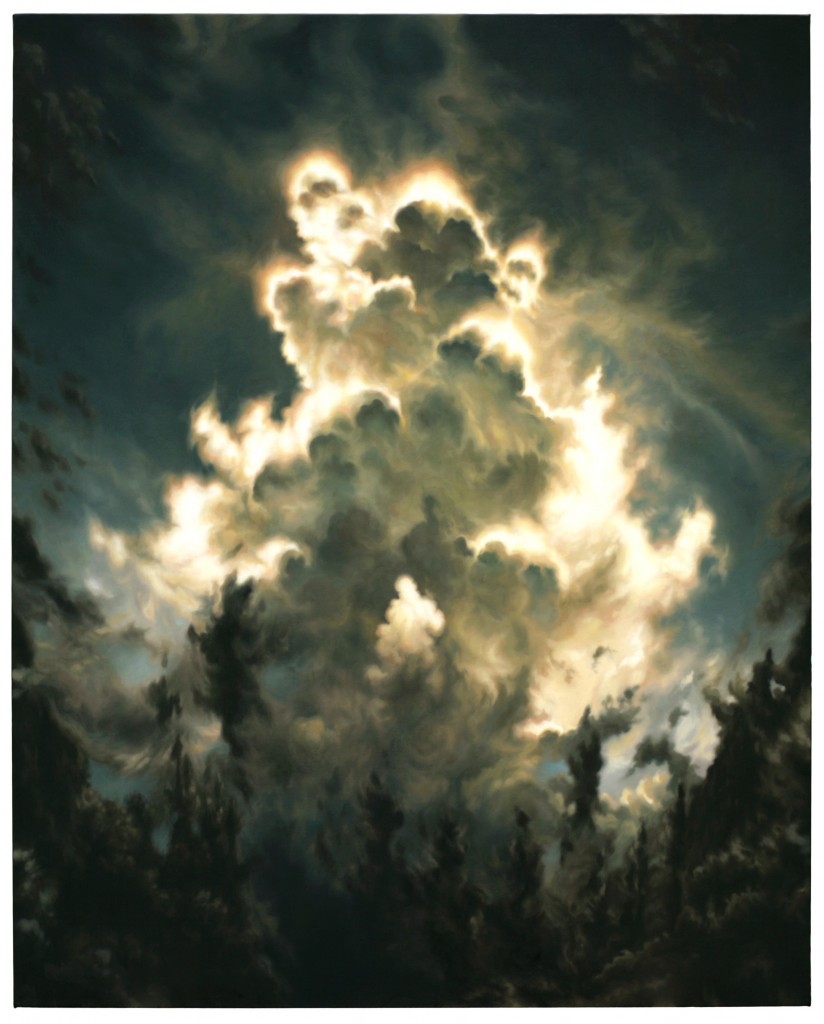
Eoin McHugh: Transparency, 2013
oil on canvas mounted on aluminium panel, 150×120 cm
Image courtesy the artist and the Kerlin Gallery.
P: There is a preoccupation throughout this exhibition with what might be termed aberrations of nature. Mutations and deformities distort the ‘natural’ or ‘normal’ order of things. On one hand this could be connected to the overall thematic of the augury as a portent of nature, which is perceived by humans as an omen of sorts. However, these recurring motifs might also be interpreted as reflecting your own ethics or thoughts regarding environmental issues such as those you previously mentioned. Can you discuss some of the imagery in the paintings in this show.
E: Following on from the last question, I would see the works more in terms of the individual’s perception of nature, or in terms of an internalised world coloured by the deeply troubled contemporary relationship between man and his environment. In this sense, it is human consciousness which is aberrant. None of the works really refer to natural forms as much as they refer to the idea of them, and the psychological or emotional charge underlying this idea. So, if we take one of the bird paintings, fruit, thing without parts, there is a nightingale and various other bird parts growing from a thorny branch. This could metaphorically refer to the interconnectedness and mutual interdependence of all living forms, the branch singing in unison with the bird, etc. I was also thinking of a Hildegard von Bingen song while developing the painting. Von Bingen was an extremely prolific medieval Christian mystic who wrote music and poetry as well as numerous texts on the natural sciences. In “O Viridissima Virga”, von Bingen compares the Virgin Mary to the greenest branch, giving life and form, while revealing and giving reality to wind and rain. Viriditas or ‘greenness’ is a very important theological concept for von Bingen, referring both to the obvious meaning of the term in relation to plant-life (life and vigour) and as a more basic, inner life force (anything life-giving or enhancing ones moral or spiritual nature has a greenness). In a sense, this painting was a meditation on greenness, a study in verdant idealism. In visual terms, it’s a near-monochrome study with the hue and saturation varied to an unrealistic degree in an attempt to test the emotional or psychological effect of colour on the perception of form. Regarding the form itself, the eyeless singing bird is another in a long line of attempts to picture grace within a dark world.
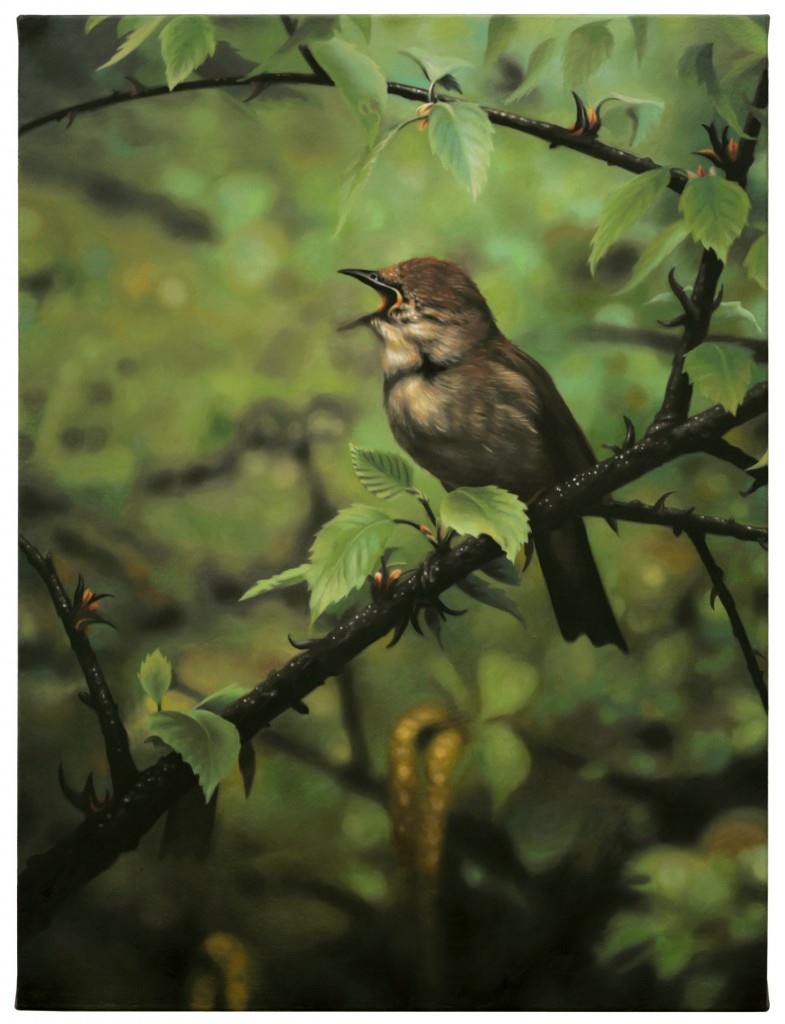
Eoin McHugh: fruit, thing without parts, 2013
oil on canvas mounted on aluminium, 47×35 cm
Image courtesy the artist and the Kerlin Gallery.
P: You are clearly deeply interested in the natural world: its paradoxical character; its incredible fragility and resilience; its ability to adapt and evolve. There is also your preoccupation with the inherent geometry and mathematical order that occurs in so many species. Do you find that submerging yourself within environments where nature flourishes helps you? Perhaps put more succinctly: do you derive a kind of faith system from the the analysis and study of nature?
E: If you don’t mind, let’s return to my decision to move from living and working in the centre of Dublin to a little cottage in the wilds of Wicklow – it is definitely quite a romantic move. This was motivated by a desire to escape from the oppressive distractions of city living, with lowest-common-denominator culture screaming from every street corner. It wasn’t a move towards nature, but a move away from the alienation of urban life. Yet it was inspired by an idealised notion of rural purity, a life of rooted tranquility. I wanted to devote myself to my practice, to find a mode of living that was truly meaningful to it, to find a mode of living which was truly meaningful—the Kierkegaardian search for an idea to live or die for.
The idea of natural order of course is simply a human construct, but its formation and function is intriguing. Take Goethe’s views on plant morphology as a model: Goethe saw basic plant forms deriving from the leaf, and all plant types deriving from the urpflanze—an archetypal, original plant. While these ideas are quite beautiful and were very important to the development of plant morphology, they are now seen as simplistic and overly romanticised. I’m fascinated by this urge to find an a priori order to the external world: the search for perfect form, the desire to mentally tame chaos, and the foundation of mortal fear which lies beneath. So again, I’m more interested in the human world than the natural. Or it might be more accurate to say that I’m more interested in the divide between the human world and the natural world. The idea that human consciousness is somehow perceived as external to the natural world is in itself very revealing. In either case, the natural world provides the basis for a perfect figurative language to refer to the internal world. With this in mind, it might be possible to draw certain motivational parallels between the development of ordered systems within biology and religion. In the most basic sense we can think of the moment within some cultures when all forms, from plant to animal, were imbued with a spirit. This is a very poetic yet systematic view of the world which finds a very fine balance between the internalisation of the world and the projection of the mind. I have a hard time fully accepting theoretical systems of any description, but I am definitely more drawn towards idealistic systems in opposition to descriptive and practical systems of control. In this regard, augury itself is quite a beautiful and revealing idea: the reading of human fate via the flight or the song of birds. We have, on the one hand, an anthropocentric view of the world and a desire to control, and on the other, a feeling of helplessness in the face of natural chaos, a desire to surrender to this and to see a certain grace and harmony in this surrender.
P: One of the aspects that distinguishes this exhibition from your previous ones is the strong presence of sculptures and objects in the gallery. Do your sculptures also contain allusions to art history as your paintings do? Or do objects in this exhibition reflect an interest in museological processes?
E: While some of my paintings do reference certain moments within art history such as Northern European Realism, Surrealism, and Magic Realism, they are certainly not motivated by the desire to be understood as such. I am more concerned with revealing a network of visual ideas through an analysis of the basic components of sight and symbolism and the underlying and interlinked psychological networks. I have no interest in making art about art, and for me at least, art has absolutely nothing to do with art. I find a lot of self-referential or self-analytical art to be painfully cynical and exclusive. I long for the possibility of subjective truth or revelation, rather than an institutionalised pandering for theoretical validation.
With the sculptural works—and the tables in particular—there is a similar search for a non-style, a somewhat clinical approach to the presentation of ideas. This obviously shares a similar motivational basis with museological presentation strategies, though there is still quite a flavour of the rapturous, rampant subjectivity of the cabinet of curiosities. In particular, I was trying to realise a categorisation of objects according to ontological categories at the same time as arranging a series of psychological test objects. In general, I was trying to examine the point of collapse of systematic analysis: where the objective meets the subjective or at least the subjective idealisation of objectivity.

Eoin McHugh: Augury, July, 2013
installation photograph
Image courtesy of the artist and the Douglas Hyde Gallery, Dublin.
P: In this exhibition there are many references to some sort of invisible energy. Several of the paintings depict scenes or occurrences that might once have been thought to be divine, but are explained through scientific laws in the contemporary world. On a personal level, are you interested in what might be termed super-physical phenomenon? By super-physical I mean all that defies rational explanation or that which may be experienced, but never successfully explained. I ask this because I believe that the visual arts are one of the the few disciplines in which certain concepts relating to the super-physical can be communicated.
E: I’m definitely interested in superphysical phenomena whether seen in terms of religion, philosophy, or psychology. I find contemporary rationalising oppressive: everyday beliefs and lifestyles seem to be shaped by an incredibly arrogant, pseudo-scientific reductivism and brutal materialism. Rather than explaining the world, this seems to allow for the most basic, unreflective and crude control over our relation to the world and each other. I love metaphysical or mystical accounts of the world, narratives which embrace the inexplicability and mystery of consciousness, and the profound simplicity of life itself. If we ignore the current cultural aversion towards the numinous or anti-theoretical, I think visual art is a vital medium to deal with these ideas. The viewer’s relation to the art object is generally conceived as a process of identification, followed by distanced appreciation which I feel functions very differently to the viewer’s passive relationship to advertising and much popular culture. It generates a meditative, introspective state that allows for a greater awareness of internal and external worlds, and the emotional, spiritual, and conceptual underpinnings of these worlds. As such, it is of course a valid medium to deal with the inexplicable. However, at the moment art seems to be caught up in a somewhat illustrative or allegorical role in relation to art theory which inevitably effects the reception and function of art. I think it was the writer Elizabeth Bruss who said that theoretical activity increases whenever the function of criticism is in question. At the moment, the lack of consensual belief in art and art theory has caused a lack of belief in art, both by artists (who seem through their work to be appealing for theoretical justification for their activities) and by the public (who seem incapable of engaging with the work without reading an explanatory text).
P: Do you think that contemporary society has been somehow damaged by the widespread adoption of cynicism and incredulity towards the type of phenomenon I previously referred to? While I think that secularism is positive I also feel that militant atheism can be an extremely negative force. Am I correct in assuming that much of your work is informed by the attitude of a secular mystic?
E: From my vantage point, I can’t pretend to speak of contemporary society without bias, though I’m certainly inclined to agree with you. I definitely know that I’ve been damaged by the adoption of cynicism and incredulity, and I’d love to be able to believe in societal and human purpose. Partly because of a fear of contemporary cynicism, I’d be wary of describing my work in the light of secular mysticism—though I’d far prefer to be seen as an artist/mystic rather than artist/theorist. If asked, I’d normally call myself a painter though I try to think of myself simply as an image-maker. I find the term artist too open-ended and fraught with all manner of misleading romantic notions (for artist and public alike). Having said all that, I certainly read a lot of writing by mystics, and the notion of artist as mystic is very interesting though difficult to theorise (and maybe it shouldn’t be). In terms of the artist’s role in society, there are a number of similar models which I find interesting. Levi-Strauss speaks of communal belief in the shaman as being the source of their power, and Julia Kristeva speaks of the role of the psychoanalyst in similar fashion: a personal belief in the role of the shaman or psychoanalyst is created by a communal belief and this faith can engender healing in the individual. I believe that communal belief in a culturally accepted narrative has to be a more positive social force than cynical individualism. However, I really don’t feel that people in general believe in the power of art. Its commonly accepted functions are inevitably touched with cynicism, leading to the visual art-object being understood as decoration, status symbol, theoretical illustration, or ultra-idiosyncratic self-expressionism. This perception certainly doesn’t engender a belief in visual art as any kind of catalyst for social or personal understanding or change. However, there somehow remains a vague yet common belief in its potentially cathartic power, in its ability to express the zeitgeist or possibly to allow the viewer to better understand themselves.

Eoin McHugh: pulse, thirst, rain inside, 2013
oil on canvas, mounted on aluminium panel 36.5 x 31.5 cm
Image courtesy of the artist and Kerlin Gallery, Dublin.
P: Your work has always emphasised the power of the visual image as a trigger or a catalyst for reaction. This is something that was obviously a concern in the exhibition which you had at Kerlin Gallery, Dublin, in 2009 which seemed to underscore the idea that viewing is an inherently subjective act shaped by ones own memory and experience. When conceiving an image, do you intend to generate something that will cause an emotional response in the viewer? I ask this because it seems to me that the content of many your earlier images have been conceived with this in mind.
E: Let’s have a look at subjectivity within visual language to begin with. If the meaning of a visual art object is placed in the communicative act, we can think of the art object as embodying a language of sorts. Any such abstract symbol-system necessarily embodies some belief in its objective truth or meaningfulness. In these terms, it’s easier to analyse verbal language. In his book Speech Acts, John Searle’s principle of expressibility states that any meaning can be given an exact expression in language, while metaphor and other figurative tropes are gratuitous, ornamental aberrations of literal language. Searle is well aware of the subjective and subversive power of these aberrations—the point where semantic ambiguity and ambivalence turn on objective truth and force a subjective response to language and the underlying systems of personal reality. Searle suggests that the reason why metaphors have such poignant beauty is that they remind us of our pre-linguistic experiences when we were separated from the outside world. He further proposes that the mutual shaping of metaphorical experience can be the most intimate psychological contact that people can share.
To me it would appear that visual language forms a closer link to the physical, emotional and perceptual history of our early linguistic and psychological development. As such, visual art can certainly be a very powerful catalyst for individual reaction and I think it is commonly understood as such. Douglas Crimp has suggested that with the current proliferation of mass media imagery our first hand experience is forced into retreat. However, visual art does not function in the same way as the mass media. It does not aim to create a passively accepted (and generally manipulative) worldview but allows for a direct, active, and personal engagement with the visual world of another. When oil painting began to take hold, it was commonly accepted by Van Eyck and other painters that what you see in the physical world becomes part of your soul. With my work, I am trying to recreate this possibility, as hopelessly idealistic as it sounds. I aim to create images which can counter the cynicism and ideological hopelessness of mass media manipulation; to create the possibility for personal understanding and change; to create objects which can allow for an intensely intimate interpersonal experience of the world. With this in mind, I put as much as I can into each painting. I explore each painterly component with as much care and attention as possible—from composition, line and colour, to various figurative tropes and symbols. Along with this, an effort is made to create or recreate certain intense emotional or psychological states while developing ideas and while painting. However, as much as I spoke previously of my intention to define my own personality for the viewer, there are of course two parties in any communicative act. I want to put the viewer first. I want to be as generous, honest, and open as I can and to produce work that is as refined, passionate, and meaningful as possible. I want to create imagery that I can believe in myself, or at least seek understanding through. I picture a viewer of unlimited sensibility and intellect who can hopefully create some meaning and purpose in what they see. To this end, I attempt to deny painting itself, with all its historical and theoretical baggage. I try to to make the painting invisible and put the image clearly in the centre of the communicative act in order to create a new memory or metaphorical fantasy for the viewer. I do my best to paint without dramatic gestures and without theoretical or historical quotations to open things up to the viewer and to a broader public unfamiliar with art history. I’m well aware that this all sounds innocent and idealistic, but I need to believe in it. I long to create an image which can truly embody my passion and ideals in all their frailty and naivety.

